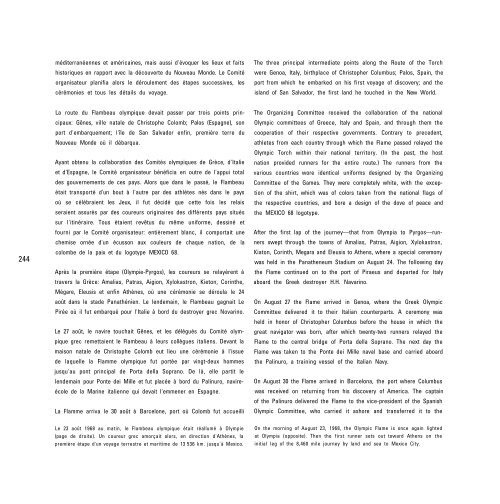Mexico City Olympic Games Official Report ... - LA84 Foundation
Mexico City Olympic Games Official Report ... - LA84 Foundation
Mexico City Olympic Games Official Report ... - LA84 Foundation
You also want an ePaper? Increase the reach of your titles
YUMPU automatically turns print PDFs into web optimized ePapers that Google loves.
244<br />
méditerranéennes et américaines, mais aussi d'évoquer les lieux et faits<br />
historiques en rapport avec la découverte du Nouveau Monde. Le Comité<br />
organisateur planifia alors le déroulement des étapes successives, les<br />
cérémonies et tous les détails du voyage.<br />
La route du Flambeau olympique devait passer par trois points prin-<br />
cipaux: Gênes, ville natale de Christophe Colomb; Palos (Espagne), son<br />
port d'embarquement; l'île de San Salvador enfin, première terre du<br />
Nouveau Monde où il débarqua.<br />
Ayant obtenu la collaboration des Comités olympiques de Grèce, d'Italie<br />
et d'Espagne, le Comité organisateur bénéficia en outre de l'appui total<br />
des gouvernements de ces pays. Alors que dans le passé, le Flambeau<br />
était transporté d'un bout à l'autre par des athlètes nés dans le pays<br />
où se célébraient les Jeux, il fut décidé que cette fois les relais<br />
seraient assurés par des coureurs originaires des différents pays situés<br />
sur l'itinéraire. Tous étaient revêtus du même uniforme, dessiné et<br />
fourni par le Comité organisateur: entièrement blanc, il comportait une<br />
chemise ornée d'un écusson aux couleurs de chaque nation, de la<br />
colombe de la paix et du logotype MEXICO 68.<br />
Après la première étape (Olympie-Pyrgos), les coureurs se relayèrent à<br />
travers la Grèce: Amalias, Patras, Aigion, Xylokastron, Kieton, Corinthe,<br />
Mégare, Eleusis et enfin Athènes, où une cérémonie se déroula le 24<br />
août dans le stade Panathénien. Le lendemain, le Flambeau gagnait Le<br />
Pirée où il fut embarqué pour l'Italie à bord du destroyer grec Novarino.<br />
Le 27 août, le navire touchait Gênes, et les délégués du Comité olym-<br />
pique grec remettaient le Flambeau à leurs collègues italiens. Devant la<br />
maison natale de Christophe Colomb eut lieu une cérémonie à l'issue<br />
de laquelle la Flamme olympique fut portée par vingt-deux hommes<br />
jusqu'au pont principal de Porta della Soprano. De là, elle partit le<br />
lendemain pour Ponte dei Mille et fut placée à bord du Palinuro, navire-<br />
école de la Marine italienne qui devait l'emmener en Espagne.<br />
La Flamme arriva le 30 août à Barcelone, port où Colomb fut accueilli<br />
Le 23 août 1968 au matin, le Flambeau olympique était réallumé à Olympie<br />
(page de droite). Un coureur grec amorçait alors, en direction d'Athènes, la<br />
première étape d'un voyage terrestre et maritime de 13 536 km. jusqu'à <strong>Mexico</strong>.<br />
The three principal intermediate points along the Route of the Torch<br />
were Genoa, Italy, birthplace of Christopher Columbus; Palos, Spain, the<br />
port from which he embarked on his first voyage of discovery; and the<br />
island of San Salvador, the first land he touched in the New World.<br />
The Organizing Committee received the collaboration of the national<br />
<strong>Olympic</strong> committees of Greece, Italy and Spain, and through them the<br />
cooperation of their respective governments. Contrary to precedent,<br />
athletes from each country through which the Flame passed relayed the<br />
<strong>Olympic</strong> Torch within their national territory. (In the past, the host<br />
nation provided runners for the entire route.) The runners from the<br />
various countries wore identical uniforms designed by the Organizing<br />
Committee of the <strong>Games</strong>. They were completely white, with the excep-<br />
tion of the shirt, which was of colors taken from the national flags of<br />
the respective countries, and bore a design of the dove of peace and<br />
the MEXICO 68 logotype.<br />
After the first lap of the journey—that from Olympia to Pyrgos—run-<br />
ners swept through the towns of Amalias, Patras, Aigion, Xylokastron,<br />
Kiaton, Corinth, Megara and Eleusis to Athens, where a special ceremony<br />
was held in the Panatheneum Stadium on August 24. The following day<br />
the Flame continued on to the port of Piraeus and departed for Italy<br />
aboard the Greek destroyer H.H. Navarino.<br />
On August 27 the Flame arrived in Genoa, where the Greek <strong>Olympic</strong><br />
Committee delivered it to their Italian counterparts. A ceremony was<br />
held in honor of Christopher Columbus before the house in which the<br />
great navigator was born, after which twenty-two runners relayed the<br />
Flame to the central bridge of Porta della Soprano. The next day the<br />
Flame was taken to the Ponte dei Mille naval base and carried aboard<br />
the Palinuro, a training vessel of the Italian Navy.<br />
On August 30 the Flame arrived in Barcelona, the port where Columbus<br />
was received on returning from his discovery of America. The captain<br />
of the Palinuro delivered the Flame to the vice-president of the Spanish<br />
<strong>Olympic</strong> Committee, who carried it ashore and transferred it to the<br />
On the morning of August 23, 1968, the <strong>Olympic</strong> Flame is once again lighted<br />
at Olympia (opposite). Then the first runner sets out toward Athens on the<br />
initial leg of the 8,460 mile journey by land and sea to <strong>Mexico</strong> <strong>City</strong>.
















